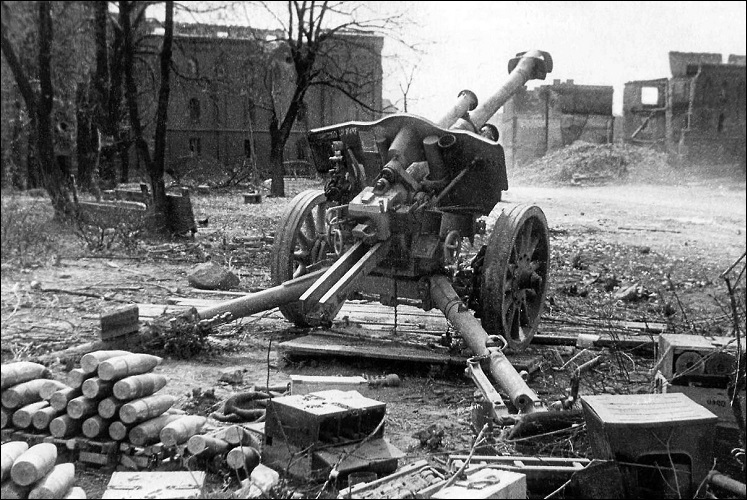The battalions
subordinate to the artillery regiments and separate
artillery battalions were called Artillerie-Abteilungen—this
being the term for battalion in certain branches of
the German Army. If necessary, artillery regiments and
battalions
had
motorisiert
appended to their titles, e.g. 15. Artillerie-Regiment (motorisiert)—often
abbreviated to (mot).
● ● ●
About 50% of the German infantry
division’s total firepower was embodied in its organic
artillery regiment. In the
Type 1939 Infanterie- Division this
regiment consisted of three light howitzer battalions (each
with 12 x 105mm howitzer), one heavy howitzer battalion (12
x 150mm howitzer) and a motorized artillery
observation battalion with calibration, sound-ranging and
flash-ranging batteries plus a weather platoon. A few also
had an observation balloon battery. After the Polish
campaign, the artillery observation battalions were
withdrawn from the divisional artillery regiments and became
part of the
Heerestruppen. The regiment's four
howitzer battalions were all horse-drawn. The regimental
headquarters and all battalion headquarters included a
communications platoon.
Such was the desired standard but
thanks to personnel and equipment shortages, only some
artillery regiments of the 1st Wave divisions achieved it.
Those of the 2nd, 3rd, 4th, 5th and 6th Waves had no
observation battalion. The 7th Wave divisions had no heavy
howitzer battalion at all and its light howitzer battalions
had only two batteries each (8 x 105mm howitzer, for a division
total of 24). As regards weapons, production was never able
to keep pace with demand and many artillery regiments had to
be equipped with guns and howitzers captured from the
Czechs, Poles, Norwegians, Belgians, French, and Soviets.
When raised, the 5th and 6th Wave divisions were armed with
howitzers acquired from the former Czech Army. In June 1944 the 716th Infantry Division in
Normandy had three artillery battalions, each with 12 x
100mm light field howitzer (Czech). Two of the
battalions had in addition a battery with 4 x 155mm
howitzers (French). The 709th Infantry Division, also in Normandy,
was equipped with captured Czech, Russian and French guns and
howitzers.
A fair number of these captured
weapons were actually of good quality but the multiplicity
of types in service by 1942 not only caused logistical
problems but made it hard to gauge the combat capability of
a given infantry division—a conundrum exacerbated by the ad
hoc reductions that often were necessary. In the spring of
1942, as the Army prepared for its summer offensive in
southern Russia, Army Group Center, facing Moscow, was
raided for the manpower and weaponry necessary to bring Army
Group South up to strength. Among other things, the firing
batteries of the divisional artillery battalions in AG
Center were reduced from four to three guns or howitzers— many of
them older models or captured stock.

Red Army troops with M1939
76.2mm field guns, hundreds of which were captured by the
Germans and used by them. (Red Army photo)
The artillery regiment of the
1944-45 Volksgrenadier-Division had four battalions:
one with 16 x 75mm field gun, two with 12 x 105mm
howitzer each and one with 12 x 150mm howitzer. The
105mm and 150mm battalions were organized with two firing
batteries (six howitzers each) instead of three firing
batteries (four howitzers each)—this to conserve manpower by
eliminating one battery headquarters element.
There were basically two types of
weapon in the German division artillery: field guns and field
howitzers. The former were low-trajectory weapons with a
longer range than a howitzer of equivalent caliber; the
latter were high-trajectory, enabling them to place fire on
targets behind terrain features like hills and ridges. The
majority of German infantry divisions had howitzers only,
but many of those raised in the last three years of the war
received field guns, often captured models like the Soviet
76.2mm M1939.
German tactical doctrine stressed
the importance of close cooperation between infantry and
artillery, and much training time was devoted to this.
Usually each of the division's three infantry regiments had
a light howitzer battalion in direct support, with the heavy
howitzer battalion available to provide general support and
reinforcing fire as needed. But great importance was also
placed on the ability of the division artillery to mass its
fire against a single target, to which end all units were
well equipped with radios and field telephones. Battery
positions were carefully selected and camouflaged. As many
as six might be prepared for an artillery battalion of three
batteries, allowing rapid displacement after firing to avoid
detection. The battery personnel were trained and equipped
as infantry, enabling them to defend their firing positions against a direct
attack.

A 105mm leFH 18,
abandoned in Königsberg at the end of the war. It was the
German Army's stand light field howitzer. (Bundesarchiv)
In addition to the division
artillery regiments, the German Army maintained a large
number of non-divisional artillery battalions, independent
batteries and artillery headquarters elements as part of the
Heerestruppen (General Headquarters Troops). Such
artillery units were allotted to corps and field army
commands as required, e.g. to support a major offensive. In
them were found most of the long-range guns and the
howitzers of 150mm caliber or greater. They were organized
in much the
same manner as the division artillery units.
Overall the German field artillery
was equal or superior to that of all its early opponents,
including the USSR. Though its artillery weapons were of excellent design and performance, the Red Army could not
procure in sufficient numbers the trained artillerymen
necessary to emulate the German system. Only in the last two
years of the war did it hit upon a
solution in
line with its resources and answerable to its need for a
powerful artillery arm.
In the final phase of the war in
the west, the artillery arms of the British and US armies
proved themselves definitely superior to that of the German
Army. Though a US infantry division had about the same
numerical artillery strength as a comparable German infantry
division—36 x 105mm howitzers and 12 x 155mm howitzers—its
four field artillery battalions were fully motorized and its
fire direction and control capabilities were significantly
more advanced. The same was true of British infantry
divisions which had three field regiments, each with 24 x
25-pounder (87.6mm) gun-howitzers. Though relatively small
in caliber, the 25-pounder had a long range and a high rate
of fire, and was generally considered to be one of the best
artillery weapons of the war.
As was the case with most branches
and services of the German Army, the infantry division
artillery could not keep pace, either numerically or
technologically, with its enemies. Armed with a variegated
assortment of weapons, largely reliant on horses for
mobility, increasingly vulnerable to attack from the air,
German artillery, like the Army as a whole, became less and
less effective as the war went on.
● ● ●